5 Factors Making Hyperscale Environments a Prime Target for Security Challenges
The world's largest data centers face nearly overwhelming security challenges. Servers that enable zero-trust operations can help provide a solution.

Sponsored by Dell Technologies
As demand for compute-intensive technologies like artificial intelligence (AI), machine learning (ML), analytics, and large-scale simulations skyrockets, large technology companies are building hyperscale data centers as fast as they can.
According to Synergy Research Group, there were 926 hyperscale data centers around the world in 2023. That's double the number in existence just five years earlier. And as companies build more -- and larger -- facilities, total hyperscale data center capability will approximately triple within the next six years.
Hyperscale data centers, which can sprawl across millions of square feet, offer a lot of economies of scale. But the cloud service providers and other companies that operate them also face some unique security challenges as a result of their size:
1. Increased Cyberattacks
Because of the enormous volumes of data they store, hyperscale environments represent a juicy prize for cybercriminals hoping to steal sensitive information. In 2022, attacks on cloud services jumped up by 95%, and they don't seem to be slowing.
According to a recent report, 95% of these attacks are financially motivated. Hackers increasingly rely on social engineering, phishing, and stolen credentials to gain access to valuable data, which often resides in the cloud. Last year, six of the top 10 largest data breaches targeted technology companies, many of them large service providers.
Hyperscale data centers are also frequent targets in cyberwarfare. For example, the US Cybersecurity & Infrastructure Agency (CISA) has issued an advisory that hyperscale operators should be on guard against Russian cyberattacks related to the ongoing war in Ukraine. Cloud providers have also reported increases in distributed denial of service attacks, which can lead to costly downtime.
Advanced persistent threats like these are both highly sophisticated and relentless. These attackers aren't going to move on just because one attempt at a breach was thwarted -- they are going to keep trying until they succeed.
2. Larger Attack Surfaces
The bigger an attack surface is, the more likely it is that an attacker will find a way in. And since hyperscale data centers have the most servers, they have the biggest attack surfaces and are therefore the most difficult to secure.
Multitenancy complicates this challenge. Because they have workloads from multiple customers residing on the same physical hardware, cloud providers face the risk that an attack on one customer could affect many others. They need to have ways to separate and segment the servers in their environment to mitigate potential damage from a security breach.
And don't forget that these facilities also need to consider physical security in addition to cybersecurity. Hyperscale operators need to have multiple lines of defense in case unauthorized people gain access to their facilities.
3. Compliance
Most cloud providers serve customers in many different countries, and they operate all over the world. That means they need to comply with a multitude of different regulations, many of which mandate different security measures.
Some of the toughest requirements are in the EU's General Data Protection Regulation (GDPR), which imposes strict fines on cloud service providers who fail to meet its requirements for protecting EU residents' personal data. But there are a host of other less well-known regulations in other jurisdictions. One database that tracks privacy regulations gets updated an average of 200 times per day as different government entities around the world change their requirements. Hyperscale providers must track -- and comply with -- these ever-changing security standards.
4. Dynamic Workloads
Organizations choose to use hyperscale computing environments specifically because they want to be able to scale their workloads up or down and turn them on or off at a moment's notice. They might want to move them to different hardware to optimize costs, or they might need to move workloads to data centers in other regions of the world in order to comply with regulations.
The dynamic nature of these virtualized and containerized workloads adds even more complexity to the hyperscale environment, which in turn, makes them even more difficult to secure.
5. Supply Chain Considerations
Hyperscale facilities often purchase enormous quantities of hardware at once -- so much hardware that they sometimes face difficulties finding what they need. Pandemics, natural disasters, and international conflict can also make sourcing even more difficult.
The supply chain also represents an attractive attack vector for attackers. If malicious actors can compromise hardware or software before it even arrives at a data center, they essentially have a back door into the facility.
How Secure Hardware Can Help
With challenges this large, no single security measure can address every issue. But part of the solution to these problems is selecting the right server hardware. Here's what you should look for:
Choose scalable servers with AI-ready capabilities and robust security features like cryptographic verification, system lockdown, and firmware protection with a silicon Root of Trust. These features will help ensure data integrity, confidentiality, and protection against cyberattacks.
Prioritize servers with integrated management tools, including secure remote access, to simplify operations in complex environments. These tools enable efficient server administration and troubleshooting while ensuring secure remote connectivity. Also those who offer an OpenBMC software options for complex, heterogenous environment.
Only consider vendors with a proven supply chain advantage that allows them to source components in tight market conditions to minimize availability disruptions. Select vendors withsupply chain hardware integrity checking to ensure security during manufacturing and delivery. This minimizes the risk of supply chain tampering and counterfeit components, enhancing the reliability of your server infrastructure.
Demand transparency and a strong commitment to security from your providers. Ensure vendors are transparent about their security practices and certifications while actively investing in research and development to address emerging threats.
For more information, click here.
About the Author(s)
You May Also Like







